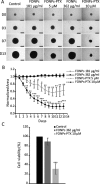Hydrophilic Fluorescent Nanoprodrug of Paclitaxel for Glioblastoma Chemotherapy
- PMID: 31720536
- PMCID: PMC6844107
- DOI: 10.1021/acsomega.9b02588
Hydrophilic Fluorescent Nanoprodrug of Paclitaxel for Glioblastoma Chemotherapy
Abstract
Highly water-soluble, nontoxic organic nanoparticles on which paclitaxel (PTX), a hydrophobic anticancer drug, has been covalently bound via an ester linkage (4.5% of total weight) have been prepared for the treatment of glioblastoma. These soft fluorescent organic nanoparticles (FONPs), obtained from citric acid and diethylenetriamine by microwave-assisted condensation, show suitable size (Ø = 17-30 nm), remarkable solubility in water, softness as well as strong blue fluorescence in an aqueous environment that are fully retained in cell culture medium. Moreover, these FONPs were demonstrated to show in vitro safety and preferential internalization in glioblastoma cells through caveolin/lipid raft-mediated endocytosis. The PTX-conjugated FONPs retain excellent solubility in water and remain stable in water (no leaching), while they showed anticancer activity against glioblastoma cells in two-dimensional and three-dimensional culture. PTX-specific effects on microtubules reveal that PTX is intracellularly released from the nanocarriers in its active form, in relation with an intracellular-promoted lysis of the ester linkage. As such, these hydrophilic prodrug formulations hold major promise as biocompatible nanotools for drug delivery.
Copyright © 2019 American Chemical Society.
Conflict of interest statement
The authors declare no competing financial interest.
Figures







References
-
- Kim S.-W.; Lee Y. K.; Kim S.-H.; Park J.-Y.; Lee D. U.; Choi J.; Hong J. H.; Kim S.; Khang D. Covalent, Non-Covalent, Encapsulated Nanodrug Regulate the Fate of Intra- and Extracellular Trafficking: Impact on Cancer and Normal Cells. Sci. Rep. 2017, 7, 6454.10.1038/s41598-017-06796-7. - DOI - PMC - PubMed
LinkOut - more resources
Full Text Sources
Other Literature Sources
Research Materials
